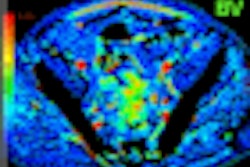CHICAGO - PET/CT showed its prowess over CT by detecting additional lesions in 23% of all cancer patients who had a conventional thoracic CT. The results come from a study of patients at the Centre Hospitalier de l'Université de Montréal (CHUM) from March to December 2007.
The study, presented Sunday at the 2008 RSNA conference, also concluded that 50% of those newly detected lesions were supraclavicular lymph nodes and most lesions should have been reported in the initial read, based on radiologic malignancy criteria.
The retrospective study reviewed consecutive files of more than 3,000 patients who underwent an oncologic PET/CT exam at the CHUM PET center over the nine-month period. In addition, patients who had a chest CT exam performed within 60 days prior to a PET/CT scan were included in the study.
Second looks
Patients' PET/CT and CT reports were reviewed to identify all PET/CT active lesions from the supraclavicular notch to the adrenals that were not noticed or reported in the thoracic CT report.
"For every patient, we looked back at the PET/CT in order to find if the lesion was described as malignant," said Dr. Jean-Charles Vinet, study co-author and presenter at RSNA. "If the lesion was not reported or was reported as benign on the chest CT, it was considered to be a discordant lesion."
For each discordant lesion, researchers returned to the original chest CT to conduct a retrospective characterization of the lesion. The original chest CT images came from six different CT scanners, ranging in technology from four-slice to 64-slice.
The images were reviewed by a radiology resident, a senior chest radiologist with more than 20 years of experience, and a PET/CT specialized nucleist with eight years of experience. The trio was asked to characterize, localize, and determine if the lesion was visible but not reported and whether the lesion was benign.
Lesion discoveries
The final analysis included 499 patients with a mean differential between exams of 29 days. Researchers discovered a total of 138 lesions in 127 patients, with the distribution of lesions found mostly in the lymph nodes and bone structures.
Researchers also conducted conclusive follow-up analyses on 92 patients. Among those patients, approximately 85% (78 patients) of the lesions were proved to be malignant.
With the 78-patient sample, 55% of the lesions were proved to be malignant and were suspicious in the retrospective chest CT. Most of those lesions were discovered in the lymph nodes, with a mean diameter of more than 15 mm.
Other undetected lesions were located within bones (18%), adrenals (6%), the liver (5%), the lung parenchyma (2%), and soft tissues (2%). Of all metabolic active lesions that were not reported on CT, 56% retrospectively had malignancy criteria.
Positive impact
"PET/CT had a positive impact in nearly 60% of the patients by detecting lesions that were not detected on chest CT," said Vinet.
In the study, the researchers noted that "more careful scrutiny may be required to assess thoracic CT in an oncologic population, especially regarding supraclavicular nodes, as the majority of overlooked lesions are neoplastic."
By Wayne Forrest
AuntMinnie.com staff writer
December 1, 2008
Related Reading
Digital chest tomo beats standard DR for pulmonary nodules, October 21, 2008
Dual-energy CT helps distinguish malignant lung nodules, October 8, 2008
Australian study underscores PET's oncology prowess, October 8, 2008
NOPR: PET changes care of more than a third of cancer patients, October 6, 2008
PET changes care of colorectal cancer patients, study shows, September 2, 2008
Copyright © 2008 AuntMinnie.com




















